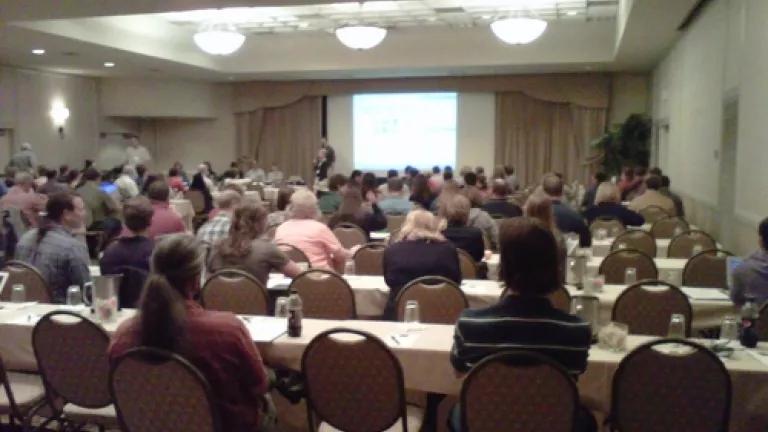
I recently got back from the annual meeting of scientists working on white-nose syndrome and I have to say – although white-nose syndrome (the fungal disease causing mass bat die-offs) is a depressing topic – this continues to be one of my favorite meetings to attend each year. It is filled with such a dedicated and inspiring group of folks that it manages to lift your spirits despite the sobering challenge of trying to address a devastating and unprecedented wildlife crisis.
The meeting brought together 170 scientists and natural resource managers with another 100 or more conferencing in from afar. Unlike most scientific conferences where people are presenting on already published results, this conference is about sharing information and data that is still in progress so that collaborations and advancements can be made as soon as possible as everyone tries to beat the clock on the on-going bat declines.
Since last year, these scientists have made significant progress towards understanding this mysterious disease. They determined that the newly described fungus found on the bats is indeed the cause of the bat deaths. They also discovered that the fungus is found in Europe where it does not affect European bats in the same way as it does in North America. They have strengthened support for the hypothesis that the fungus was accidentally introduced to North America from Europe (versus being a newly mutated fungus originating in North America), though they still do not have a conclusive link to a European source. They also believe that there may be signs of some bats surviving the disease – after 90% population declines – though work is still ongoing to determine whether the bat numbers they are seeing represent bats that have been exposed to the fungus and survived rather than representing the consolidation of bats that have as of yet escaped infection. Research on potential treatments as well as many other aspects of the disease dynamics is still underway.
In the meantime, the management agencies have made progress on developing and implementing the National Plan which includes subgroups on disease diagnostics, epidemiology, surveillance, conservation and recovery among others. They are developing a national strategy for bat monitoring and developing recommendations for captive management of sensitive and endangered species as well as reviewing guidance for cave closures and decontamination procedures. All federal agencies that manage public lands with bat resources were at the meeting as well as state managers, agency and academic scientists and NGOs. It’s really an extraordinary collegial and collaborative effort.
Tremendous challenges remain. Take, for example, the Bureau of Land Management that manages 245 million acres of public land in the west and whose cave resources (let alone bat populations) are not well surveyed. Also, I’ve written before about the challenges of developing and implementing anti-fungal treatments in a cave environment. These efforts are particularly resource intensive and yet could prove critical to stemming the loss of bat populations nationwide. But all of this work takes time and all of it takes money.
At NRDC we have focused our efforts on trying to secure federal funding to ensure that this type of research and agency response is possible. Thanks to the support of some Senate champions including Senator Leahy and Senator Lautenberg, and leadership from the US Fish and Wildlife Service, several millions of dollars in research grants plus additional agency resources have been put towards tackling this disease.
Although white-nose syndrome continues to spread with reports of newly infected locations and the recent discovery of another endangered species, the gray bat, succumbing to infection, witnessing the efforts of the group at this meeting gives me full confidence that any resources put towards this work is time and money well spent. In fact, given the ecological and economic consequences of a future without bats, we can’t afford not to support this research. Without a doubt, continuing to secure additional resources for this great group of scientists is still the most important thing we can do to give the bats – and our ecosystems – a fighting chance.
Take a minute to give the scientists a hand by telling your representatives that you support continued funding to address white-nose syndrome here.
Photo: USGS

